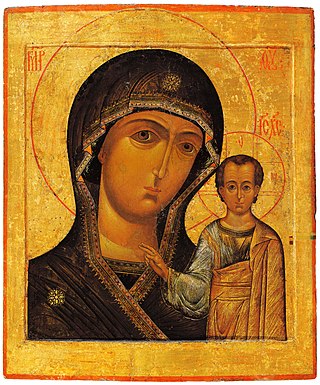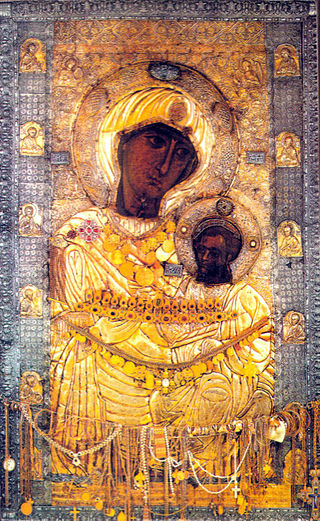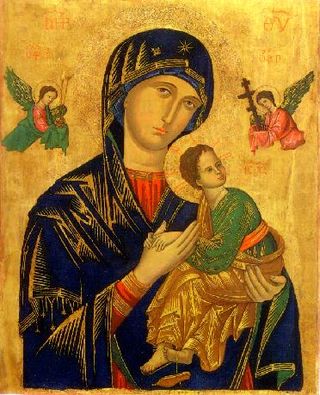
Panagia Nafpaktiotissa also known as Panagia tis Nafpaktos or Madonna di Lepanto is an icon of the Virgin Mary and a temple closely connected with the history of Nafpaktos, possibly as early as the 5th century AD. [1]

Panagia Nafpaktiotissa also known as Panagia tis Nafpaktos or Madonna di Lepanto is an icon of the Virgin Mary and a temple closely connected with the history of Nafpaktos, possibly as early as the 5th century AD. [1]
The case of the Virgin of Nafpaktos is inextricably linked to the historical Byzantine parchment kept in Palermo, Sicily, specifically in the archive of the Regia Cappella Palatina (State Museum of the Palace Chapel). This parchment is a copy of the charter of a religious brotherhood of the 10th century, which was active in the region of Thebes and whose center of honor and worship was the icon of the "Most Holy Theotokos of Nafpaktitis" which was kept in the Monastery of Nafpaktitis. The parchment was probably found in Palermo after and because of the Norman raid on the city of Thebes in 1147. [2] [3]
According to the testimony of the charter, the brotherhood was founded in 1048 AD. The statute is signed by 19 clergy and 30 lay people, including women. The purposes of the fraternity are primarily spiritual in nature. The form and honor of the Virgin and her icon dominates. Every month the Virgin visited the homes of the members and was honored with sacred rituals. The brotherhood also dedicated its prayers to the health of its members and to their general good condition here and beyond the grave. [4]
At her head, the parchment bears a miniature of the Virgin Mary standing on a marble floor and wearing a blue mantle and a purple tunic. Panagia is in prayer position. The specific iconographic type of the Virgin Mary was established from the middle of the 1st century. In all probability, this particular miniature is a copy of the icon of the Virgin of Nafpaktiotissa which was either brought to Thebes from Nafpaktos, or was a copy of the original. However, the cult of this particular image so far from its headquarters is evidence of its widespread honor. [5]
The temple probably dates from the 5th century. This pilgrimage was famous during the years of the Byzantine Empire and the Frankish rule and enjoyed privileges and donations from kings and emperors as the learned Metropolitan of Nafpaktos Ioannis Apokaykos (1217 AD) saves us. Among them are the emperors Alexios I Komnenos (1081-1118) and Michael I Komnenos (1143-1180). In Chrysoboulos of Theodoros Angelos Komnenos Doukas, Despot of Epirus, issued in May 1228, at the request of Apokaukos, his decision to help the metropolitan temple of Nafpaktos as a dedication to the city's patroness Theotokos is mentioned. [6]
When the time came for the infamous Naval Battle of Nafpaktos, Pope Pius V ordered for the first time the use of the rosary with the request to the Virgin Mary to bring victory to the allied Christians against the Turks, who until then were invincible in sea. When victory unexpectedly came, it was attributed to the intervention of the Virgin Mary. Our Lady of Nafpaktos has since been called Santa Maria del Rozario or Madonna di Lepanto del Rozario in the West. The Pope designated October 7 as a feast day for the Virgin Mary of Nafpaktos for the entire Christian West. The Battle of Nafpaktos inspired many artists including the great Tisianos, Vicentinos and Domenikos Theotokopoulos. In many similar paintings, the Virgin Mary is depicted blessing and giving victory to Christians. Piemonte Chilardi wrote that, not the valor, nor the weapons, nor the leaders, but the Virgin gave the victory. The Venetian Republic wrote the same in the Palazzo Ducale: Non virtus, non arma, non duces, sed Maria Rozarii vit ores nos feces. [7]

Theotokos is a title of Mary, mother of Jesus, used especially in Eastern Christianity. The usual Latin translations are Dei Genitrix or Deipara. Familiar English translations are "Mother of God" or "God-bearer" – but these both have different literal equivalents in Ancient Greek: Μήτηρ Θεοῦ, and Θεοφόρος respectively.

September 7 - Eastern Orthodox liturgical calendar - September 9

March 24 - Eastern Orthodox liturgical calendar - March 26

Our Mother of Perpetual Succour, colloquially known as Our Lady of Perpetual Help), is a Catholic title of the Blessed Virgin Mary associated with a 15th-century Byzantine icon and a purported Marian apparition. The image was enshrined in the Church of San Matteo in Via Merulana from 1499 to 1798 and is today permanently enshrined in the Church of Saint Alphonsus of Liguori in Rome, where the novena to Our Mother of Perpetual Help is prayed weekly.

Panagia, in Medieval and Modern Greek, is one of the titles of Mary, mother of God, used especially in Orthodox Christianity and Eastern Catholicism.

A prosphora is a small loaf of leavened bread used in Orthodox Christian and Greek Catholic (Byzantine) liturgies. The classical plural form is prosphorai (προσφοραί). The term originally meant any offering made to a temple, but in Orthodox Christianity and Byzantine Rite Catholicism it has come to mean specifically the bread offered at the Eucharist during Divine Liturgy.

October 6 - Eastern Orthodox liturgical calendar - October 8
An Akathist or AcathistHymn is a type of hymn usually recited by Eastern Orthodox and Byzantine Catholic Christians, dedicated to a saint, holy event, or one of the persons of the Holy Trinity. The name derives from the fact that during the chanting of the hymn, or sometimes the whole service, the congregation is expected to remain standing in reverence, without sitting down, except for the aged or infirm.

A Hodegetria, or Virgin Hodegetria, is an iconographic depiction of the Theotokos holding the Child Jesus at her side while pointing to him as the source of salvation for humankind. The Virgin's head usually inclines towards the child, who raises his hand in a blessing gesture. Metals are often used to draw attention to young Christ, reflecting light and shining in a way to embody divinity. In the Western Church this type of icon is sometimes called Our Lady of the Way.

The Panagia Portaitissa also known as the Iviron Theotokos or Iverskaya in Russian, is an Eastern Orthodox icon of the Virgin Mary in the Georgian Iviron monastery on Mount Athos in Greece, where it is believed to have been since the year 999. According to the sacred tradition of the Eastern Orthodox Church it was painted by Luke the Evangelist. The icon is referred to as "Wonderworking" meaning that numerous miracles have been attributed to the intercession of the Theotokos by persons praying before it. The synaxis for this icon is on February 12, as well as on Bright Tuesday, and also on October 13 for the translation to Moscow of the Iveron icon.

Mary, the mother of Jesus in Christianity, is known by many different titles, epithets, invocations, and several names associated with places.

Emmanuel Tzanes, also known as BounialisEmmanuel Tzane-Bounialis, Emmanuel Zane, and Emmanuel Tzane, was a Greek Renaissance painter, author, clergyman, and educator. He spent the latter half of his life in Venice, where he was parish priest of the church of San Giorgio dei Greci and a member of the Flanginian School run by the city's Greek Confraternity. Tzanes painted in the style of the Cretan School, influenced by contemporary trends in Venetian painting. His known extant works, over 130 in number, can be found in public foundations, private collections, churches and monasteries in Greece. The most popular of these is The Holy Towel, finished in 1659. Tzanes was a collaborator with Philotheos Skoufos, and brothers with the painter Konstantinos Tzanes and the poet Marinos Tzanes.
Marian feast days in the liturgical year are celebrated in honour of the Blessed Virgin Mary. The number of Marian feasts celebrated, their names can vary among Christian denominations.

Mary has been one of the major subjects of Western art for centuries. There is an enormous quantity of Marian art in the Catholic Church, covering both devotional subjects such as the Virgin and Child and a range of narrative subjects from the Life of the Virgin, often arranged in cycles. Most medieval painters, and from the Reformation to about 1800 most from Catholic countries, have produced works, including old masters such as Michelangelo and Botticelli.

Bogorodica Trojeručica or simply Trojeručica is an Eastern Orthodox wonderworking icon believed to have been produced in the 8th century in Palestine by John of Damascus. It depicts Theotokos with young Jesus in the hodegetria position, and is covered with a riza. On the back of the icon is the painting of St Nicholas. It is today found in the Hilandar Monastery on Mount Athos, Greece, and is the most important icon of the Serbian Orthodox Church.

The Cincture of the Theotokos is believed to be a relic of the Theotokos, now in the Vatopedi monastery on Mount Athos, which is venerated by the Holy Eastern Orthodox Church. The word "cincture" is sometimes also translated as "belt", "sash" or "girdle". Its feast day is September 13.

Panagia-Katakekrymeni-Portokalousa Argous is a former monastery and church in Argos on the slopes of Mount Larissa, roughly translating to "Our Hidden Lady the Orange-Bearer of Argos." Its official title is the Monastery of the Entry of the Most Holy Theotokos into the Temple, but it derives its popular name from the secreting of an ancient icon of Panagia in a cave below the church, hidden by the branches of orange trees.

The Panagia Agiosoritissa or Hagiosoritissa is the name for a type of Marian icon, showing Mary without child, slightly from the side with both hands raised in prayer. The type is known in Latin as Maria Advocata.

The Holy Monastery Panagia Gorgoepikoos is an ecclesiastical institution-monastery of the 20th century, which is located in the region of Mandra, Attica and belongs to the Holy Metropolis of Megara and Salamis. It is a women's monastery to which the faithful attribute numerous miracles connected to the holy icon of the Most Holy Theotokos. The monastery is located on a hill that dominates the area with a view towards the Thriasio Pedio and the Gulf of Elefsina.

The Holy Monastery of Holiness Pephaneromeni Theotokos of Lefkada is a historical monastery located in Lefkada. Just 3 km from the town of Lefkada, it has been the religious center of the island for centuries as the oldest and largest monastery, but also the religious point of reference for Lefkadians everywhere.